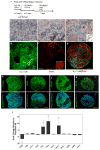Elimination of tumorigenic stem cells from differentiated progeny and selection of definitive endoderm reveals a Pdx1+ foregut endoderm stem cell lineage
- PMID: 21130058
- PMCID: PMC3040268
- DOI: 10.1016/j.scr.2010.10.003
Elimination of tumorigenic stem cells from differentiated progeny and selection of definitive endoderm reveals a Pdx1+ foregut endoderm stem cell lineage
Abstract
Embryonic stem cell (ESC) derivatives offer promise for generating clinically useful tissues for transplantation, yet the specter of producing tumors in patients remains a significant concern. We have developed a simple method that eliminates the tumorigenic potential from differentiated ESC cultures of murine and human origin while purifying lineage-restricted, definitive endoderm-committed cells. A three-stage scheme utilizing magnetic bead sorting and specific antibodies to remove undifferentiated ESCs and extraembryonic endoderm cells, followed by positive selection of definitive endoderm cells on the basis of epithelial cell adhesion molecule (EpCAM) expression, was used to isolate a population of EpCAM(+)SSEA1(-)SSEA3(-) cells. Sorted cells do not form teratomas after transplantation into immunodeficient mice, but display gene and protein expression profiles indicative of definitive endoderm cells. Sorted cells could be subsequently expanded in vitro and further differentiated to express key pancreas specification proteins. In vivo transplantation of sorted cells resulted in small, benign tissues that uniformly express PDX1. These studies describe a straightforward method without genetic manipulation that eliminates the risk of teratoma formation from ESC differentiated derivatives. Significantly, enriched populations isolated by this method appear to be lineage-restricted definitive endoderm cells with limited proliferation capacity.
Copyright © 2010 Elsevier B.V. All rights reserved.
Figures







References
-
- Alper J. Geron gets green light for human trial of ES cell-derived product. Nat Biotechnol. 2009;27:213–214. - PubMed
-
- Amariglio N, Hirshberg A, Scheithauer BW, Cohen Y, Loewenthal R, Trakhtenbrot L, Paz N, Koren-Michowitz M, Waldman D, Leider-Trejo L, Toren A, Constantini S, Rechavi G. Donor-derived brain tumor following neural stem cell transplantation in an ataxia telangiectasia patient. PLoS Med. 2009;6:e1000029. - PMC - PubMed
-
- Ishii T, Yasuchika K, Machimoto T, Kamo N, Komori J, Konishi S, Suemori H, Nakatsuji N, Saito M, Kohno K, Uemoto S, Ikai I. Transplantation of embryonic stem cell-derived endodermal cells into mice with induced lethal liver damage. Stem Cells. 2007;25:3252–3260. - PubMed
-
- Kroon E, Martinson LA, Kadoya K, Bang AG, Kelly OG, Eliazer S, Young H, Richardson M, Smart NG, Cunningham J, Agulnick AD, D’Amour KA, Carpenter MK, Baetge EE. Pancreatic endoderm derived from human embryonic stem cells generates glucose-responsive insulin-secreting cells in vivo. Nat Biotechnol. 2008;26:443–452. - PubMed
Publication types
MeSH terms
Substances
Grants and funding
LinkOut - more resources
Full Text Sources
Other Literature Sources
Miscellaneous

